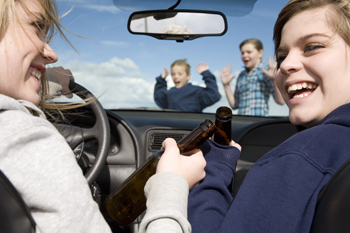Driving is a risky activity. Getting into an accident can have serious consequences.
As a driver, you make decisions about risks based on how well you judge risk, and how much risk you decide is acceptable.
Your attitude will determine what risks you take.
Some drivers do not understand the amount of risks that is involved when driving. They feel that they are invincible, and traffic laws or driving safety rules do not apply to them. The traffic laws and defensive driving rules have been created to reduce the risk of accidents. When you break the traffic laws or do not apply safe driving techniques while driving, you increase your chance of getting into an accident.
Below are a few factors outside of your control that can increase accident risks:
- Poor visibility and/or slippery roads that are more likely caused by bad weather conditions.
- Night driving.
- Driving on rural roads or roads that are not maintained.
- When there are drivers on the roads who are not following the traffic rules.
- During the busy traffic hours when traffic is bad.
- During the late night hours when drivers are more fatigue.
- When there is a road work.
- When the traffic lights are not working.
- When there are traffic accidents on the road.
Avoid the below risky behaviors and situations to reduce your chances of getting into an accident:
- Driving when you had a drink or two, or when you are under the influence of drugs or alcohol.
- Driving while you are distracted (e.g., while you are texting or using your cell phone).
- Driving when you are fatigued.
- Driving too fast when the roads are slippery or when weather is bad, such as in fog, rain, snow.
- Ignoring traffic laws, such as speeding, passing a stop sign/light, passing illegally, etc.
- Tailgating other drivers.
- Not using your headlights or turn signals at appropriate times.
- When you are in a hurry or not in the right frame of mind.
- When you drive your car and your car is not safe to drive (e.g., when your car's tires are not safe or your brakes are not functioning).
Below are just a few things you can do to reduce your chances of sustaining major injuries in case of an accident:
- Always wear your seatbelt while driving.
- If you have a child in the car, make sure to use child safety seat.
- Be a safe and responsible driver by following traffic rules and drive at the safe speed.

Teen Driving Risks
Teen drivers have additional unique risk factors below:
- Lack of driving experience, which can lead to poor decisions and dangerous situations.
- Feeling invincible behind the wheel. It may seem as if crashes only happen to other people, or that risks are not a big deal if no one gets hurt. This kind of thinking is a warning sign for at-risk driving behavior.
- Teens with passengers in the car have higher crash rates.
- Some teen drivers tend to think it is cool to drink, and some drink and get behind the wheel. Driving under the influence of drugs or alcohol is dangerous and illegal. Most accidents that occur under the influence tend to be fatal and have serious consequences.
